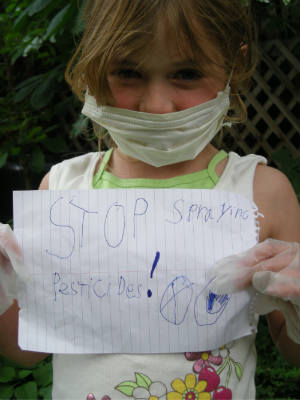
As the BC Legislature’s Special Committee on Cosmetic Pesticides grapples with the question of whether to ban the use of cosmetic pesticides, a recent report by Health Canada seems to confirm that humans, pets and the environment have something to fear from such pesticides. The Pesticide Incident Reporting Program – Third Annual Report, released on April 27th, found that a large portion of reported pesticide poisonings and other unexpected side effects involve domestic pesticides used in people’s homes.
Pesticide “Incidents”
In the three years since the Pesticide Incident Reporting Program began accepting incident reports from pesticide companies or affected members of the public, the program has received approximately 3,330 incident reports from Canadian sources – reports describing effects which might be traced to the use of a pesticide. 1,867 incidents were reported in 2010.
Of the incident reports from 2007 to 2010 there were approximately 1,005 involving humans, and 2,699 involving domestic animals (some involved both – hence the larger number of incidents). Health Canada’s report emphasizes just how many of the incidents involved “domestic class” pesticides – meaning those approved for home use:
Domestic class products were involved in 86% of all Canadian incident reports and commercial products represented 12% of products involved. For incidents in which a product was applied, it was reported that the product was not used according to the label directions 21% of the time, and that label directions were followed 34% of the time. …
The majority of the incident reports submitted in 2010 were categorized as domestic animal incidents (71%) followed by human (13%), packaging failure (10%), environment (5%), scientific study (1%) and food residue (<1%) incidents. Most incidents related to the use of a pesticide product (as opposed to a pesticide spill, for example), with the treatment of animals as the most frequently reported site, followed by the treatment of outdoor and indoor residential sites.
Of the human incidents reported in 2010, 70% occurred in a non-occupational setting.
Of these, a little over half of the affected people reported exposure to the pesticide through activities associated with product application, mostly as a result of treating residential indoor sites. The second most commonly reported activity involved contact with a treated area, such as playing on treated sites.
Fortunately, only 14 of the human incidents between 2007 and 2010 were classified as “Death/Major” (including 2 deaths), but the symptoms suffered by humans who were reported as “Moderate/Minor” sound alarming as well:
The human incidents generally involved short-term exposure. Symptoms in most people occurred within 24 hours following exposure to the product and lasted for more than 30 minutes but less than three days. … The symptoms most frequently reported in human incidents were skin irritation (including red or itchy skin), headache, nausea or vomiting, eye irritation, dizziness, shortness of breath and coughing. These symptoms are considered minor in severity, as they are minimally bothersome, and normally only last a short time.
Most of the incidents involving pets (primarily cats and dogs) involved the direct treatment involving a pesticide (such as a flea or tick spray), and the report does not provide a breakdown of the other sources of exposure leading to the incidents. However, 46% of incidents involving dogs involved an exposure that did not involve direct treatment, so it’s fair to assume that at least some were indirectly exposed through residential pesticide use.
Questions
Personally I think that the large percentage of pesticide incidents that involve residential use probably says something about the under-reporting of work-place incidents. Similarly, the very small numbers of environmental incidents (5%), probably suggests that people are quick to report incidents that involve them personally, or their pets, but less likely to pick up the phone, or even to notice, when the pesticide accidently impacts wildlife or ecosystems.
But regardless of the actual figures, it is clear that a significant number of people and pets are being poisoned from residential pesticide use – including pesticides that are being used in accordance with the legal requirements set by Health Canada.
With this in mind, and the Legislative Committee in Victoria expected to turn in a report any day, the question is – will BC join the other provinces that have already banned cosmetic pesticide use, or will they continue to put their faith in Health Canada’s assurances that they can regulate these products safely?
And how can Health Canada maintain that domestic pesticides are safe given that 84% of the reported pesticide incidents involve these very pesticides? Health Canada is using the incident reports to inform future investigations of pesticides, and to modify label requirements (for example, one pesticide that resulted in several cases of eye irritation now has a label that warns of potential eye irritation).
But the real question is how did these pesticides come to be approved in the first place? Under the Pest Control Products Act, Health Canada is only supposed to approve pesticides (sections 2(2) and 8):
if there is reasonable certainty that no harm to human health, future generations or the environment will result from exposure to or use of the product, taking into account its conditions or proposed conditions of registration.
On paper this is a very precautionary test. Do over 1,000 health impacts to humans over 3 years signal that the test is not being applied well? Is “no harm to human health” being interpreted in a very relaxed way?
Update: As we go to press, we’ve learned that Parliament is planning to initiate a review of the Pest Control Products Act in 2013. Stay tuned for details as we hear them.

Photo courtesy of Kerry Bokenfohr